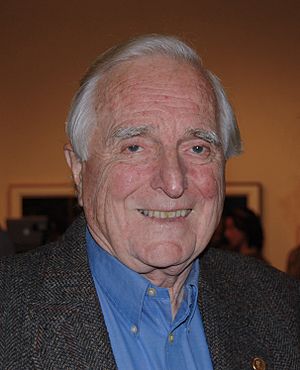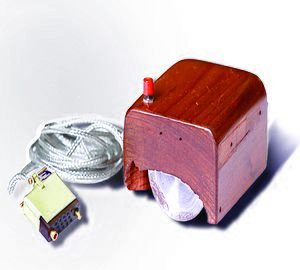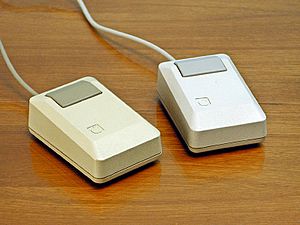Douglas Engelbart facts for kids
Quick facts for kids
Douglas Engelbart
|
|
|---|---|

Douglas Engelbart in 2008
|
|
| Born |
Douglas Carl Engelbart
January 30, 1925 Portland, Oregon, U.S.
|
| Died | July 2, 2013 (aged 88) Atherton, California, U.S.
|
| Alma mater | Oregon State University (BS 1948) University of California, Berkeley (MS 1953, PhD 1955) |
| Known for | Computer mouse Hypertext Groupware Interactive computing |
| Awards | National Medal of Technology (2000), Lemelson-MIT Prize, ACM Turing Award (1997) BCS Lovelace Medal (2001), Norbert Wiener Award for Social and Professional Responsibility, Computer History Museum Fellow Award (2005) NAE Member (1996) |
| Scientific career | |
| Fields | Human–computer interaction Inventor |
| Institutions | SRI International, Tymshare, McDonnell Douglas, Bootstrap Institute/Alliance, The Doug Engelbart Institute |
| Thesis | A Study of High-Frequency Gas-Conduction Electronics in Digital Computers (1956) |
| Doctoral advisor | Paul L. Morton John R. Woodyard |
| Influences | Vannevar Bush |
| Influenced | Alan Kay, Bret Victor |
Douglas Carl Engelbart (born January 30, 1925 – died July 2, 2013) was an amazing American inventor and engineer. He was a true pioneer in the world of computers and the internet.
He is most famous for his work on how people use computers. While at his special lab, the Augmentation Research Center (ARC) at SRI International, he helped create many things we use today. These include the computer mouse, hypertext (like links on the internet), and early versions of graphical user interfaces (the colorful screens we see). He showed all these inventions at a famous presentation in 1968 called The Mother of All Demos. There's even a rule named after him, Engelbart's Law, which says that human performance improves super fast over time.
His lab developed the oN-Line System (NLS). This system showed off many technologies that are now common. These included the computer mouse, screens that showed detailed pictures, and hypertext. All of these were part of "The Mother of All Demos" in 1968. Later, his lab moved to a company called Tymshare, and then to McDonnell Douglas. At these companies, Engelbart didn't get much support or money for his ideas. He retired in 1986.
In 1988, Engelbart and his daughter Christina started the Bootstrap Institute. It's now known as The Doug Engelbart Institute. They wanted to share his big ideas, especially at Stanford University. In 2000, U.S. President Bill Clinton gave Engelbart the National Medal of Technology, the top award for technology in the U.S. In 2008, SRI honored Engelbart for the 40th anniversary of his famous "Mother of All Demos."
Contents
Early Life and Education
Douglas Engelbart was born in Portland, Oregon, on January 30, 1925. His parents were Carl and Gladys Engelbart. His family came from Germany, Sweden, and Norway.
He was the middle child, with an older sister, Dorianne, and a younger brother, David. His family lived in Portland, Oregon, and then moved to the countryside when he was eight. His father passed away a year later. He finished high school at Franklin High School in 1942.
During college at Oregon State University, he spent two years in the United States Navy. He worked as a radio and radar technician in the Philippines. While there, he read an article by Vannevar Bush called "As We May Think." This article greatly inspired his future work. He returned to Oregon State and earned his degree in electrical engineering in 1948.
After college, he worked at the National Advisory Committee for Aeronautics at the Ames Research Center. He met Ballard Fish there, and they married in 1951. Soon after, Engelbart went to the University of California, Berkeley for graduate school. He studied electrical engineering with a focus on computers. He earned his master's degree in 1953 and his PhD in 1955.
Career and Amazing Inventions
His Guiding Idea
Engelbart's career path became clear in 1950. He realized he wanted to focus on making the world a better place. He thought that if people could work together more effectively, they could solve big problems faster.
He believed that computers could help people work together much better. He imagined people sitting at "working stations" with screens, exploring information, and using their combined brainpower to solve important problems. This idea of using computers to help people think and work together became his life's goal. This was at a time when most people saw computers only as machines for crunching numbers.
After getting his PhD, Engelbart worked at Berkeley for a year. But he couldn't pursue his big vision there. So, he started his own company, Digital Techniques. However, he soon decided to focus on the research he had been dreaming about since 1951.
SRI and the Augmentation Research Center
Engelbart joined SRI International in 1957. He worked on magnetic devices and making electronics smaller. In 1962, he wrote a report about his vision called Augmenting Human Intellect: A Conceptual Framework. This paper described how computers could help people think and work better.
This report helped him get money from ARPA (a government agency) to start his work. Engelbart then gathered a research team for his new Augmentation Research Center (ARC) at SRI. He set up special rules for his lab to help them invent things faster.
The ARC team became the main force behind creating the oN-Line System (NLS). He and his team developed many computer features we use today. These include screens that show detailed pictures, the computer mouse, hypertext, tools for working together, and early versions of graphical user interfaces. He came up with many of these ideas in the mid-1960s. This was long before personal computers existed, when most people couldn't use computers directly.
Engelbart applied for a patent for the computer mouse in 1967 and got it in 1970. It was a wooden shell with two metal wheels. He developed it with his lead engineer, Bill English, before 1965. The patent described it as an "X-Y position indicator for a display system." Engelbart later said it was called the "mouse" because the cord looked like a tail. His group also called the on-screen cursor a "bug," but that name didn't stick.
He never received any money from royalties for inventing the mouse. He once said that SRI, which patented it, licensed it to Apple Computer for only about $40,000. Engelbart showed off the chorded keyboard and many other inventions from his lab in 1968 at "The Mother of All Demos."
Later Years and the Doug Engelbart Institute
By the mid-1970s, Engelbart became less well-known. Some of his researchers left his lab for Xerox PARC. This was partly because they had different ideas about the future of computers. Engelbart believed in large, shared computers that many people could use at once. But younger programmers preferred personal computers.
Funding for his lab also decreased in the early 1970s. In 1976, SRI moved Engelbart's lab to Tymshare. Tymshare hired most of the lab's staff, including Engelbart himself. They renamed the NLS software Augment.
At Tymshare, Engelbart found it hard to continue his research. The company focused more on daily operations than on his new ideas. The same happened when McDonnell Douglas bought Tymshare in 1984. Engelbart retired from McDonnell Douglas in 1986. He was determined to continue his work without business pressures.
Working with his daughter, Christina Engelbart, he started the Bootstrap Institute in 1988. This institute, later called the Doug Engelbart Institute, aimed to share his ideas. They offered seminars at Stanford University. In the mid-1990s, they even received some funding to update the Augment user interface.
Engelbart was the Founder Emeritus of the Doug Engelbart Institute. The Institute promotes his idea of "Collective IQ." This means dramatically improving how we can solve important problems together. In 2005, Engelbart received a grant to fund the open-source HyperScope project. This project aimed to recreate Augment's special viewing and linking features for web browsers.
Engelbart attended the Program for the Future 2010 Conference. Many people came together to discuss how to follow his vision of improving collective intelligence.
His book, Boosting Our Collective IQ, published in 1995, explains his ideas in detail. It includes three of his most important papers.
Douglas Engelbart had four children with his first wife, Ballard, who passed away in 1997. He married Karen O'Leary Engelbart in 2008. Engelbart passed away at his home in Atherton, California, on July 2, 2013, at the age of 88. He had been battling Alzheimer's disease since 2007. He was survived by his second wife, his four children, and nine grandchildren.
Honors and Awards
Since the late 1980s, many important people and groups have recognized Engelbart's huge contributions. In 1995, he received the first Yuri Rubinsky Memorial Award. In 1997, he won the Lemelson-MIT Prize of $500,000, one of the biggest awards for invention. He also received the ACM Turing Award, which is like the Nobel Prize for computing.
In 1998, Stanford University hosted a special event called Engelbart's Unfinished Revolution. This event honored Engelbart and his ideas. He was also inducted into the National Inventors Hall of Fame in 1998.
The Association for Computing Machinery (ACM) SIGCHI gave Engelbart the CHI Lifetime Achievement Award. He also received the Benjamin Franklin Medal in 1999. In 2000, he organized "The Unfinished Revolution – II" to share his work with more people.
In December 2000, U.S. President Bill Clinton awarded Engelbart the National Medal of Technology. In 2001, he received the British Computer Society's Lovelace Medal. In 2005, he became a Fellow of the Computer History Museum. He was honored for his work on how humans and computers interact, for developing the mouse, and for using computers to make organizations more efficient. He also received the Norbert Wiener Award for Social and Professional Responsibility.
On December 9, 2008, Engelbart was honored at the 40th Anniversary celebration of "The Mother of All Demos". This event was held at Stanford University. Many people from his original team and other computer pioneers spoke.
In 2009, the New Media Consortium recognized Engelbart for his lifetime achievements. In 2011, he was inducted into IEEE Intelligent Systems' AI's Hall of Fame. He also received an honorary Doctor of Engineering and Technology degree from Yale University in May 2011.
See also
 In Spanish: Douglas Engelbart para niños
In Spanish: Douglas Engelbart para niños
- Dynamic knowledge repository
- Global brain
- List of pioneers in computer science



